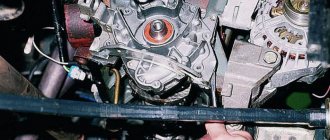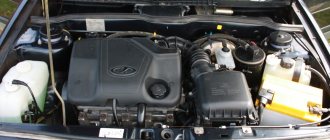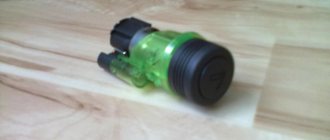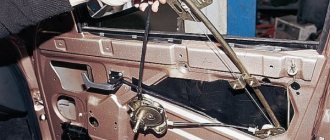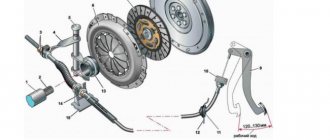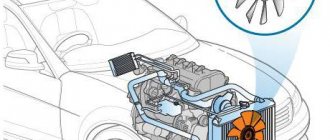If you have lost oil pressure in a VAZ-2106 car, the control light is constantly on or flashes periodically, then you need to urgently take measures to fix the problem. Otherwise, there is a very high risk of engine failure, the repair of which will be quite expensive. Why does blood pressure decrease and what to do in this situation?
When might the warning light come on?
The oil pressure in the engine can drop for various reasons, some of them are insignificant and do not cause harm to the engine, while others, on the contrary, can cause serious damage to the power plant, which can only be eliminated by carrying out a major overhaul.
Therefore, the lighting of a special warning lamp is a serious reason to start looking for the cause.
The oil pressure light can come on in a variety of situations, starting with the fact that it simply does not go out after starting the engine and glowing while driving.
This problem can appear both “hot” and “cold”, at medium loads and at idle, as well as after a planned replacement of the lubricant (especially when switching to a new brand of oil).
When the pressure warning light comes on, this is not a situation where “I’ll just get home and see.” When such a signal appears, measures should be taken immediately.
The first thing to do is to immediately turn off the engine and stop driving. And then look for the cause on the spot or organize delivery of the car to the repair site (by tug, tow truck).
Note that sometimes failures in the sensor occur, so as one of the first measures you should wait 3-5 minutes and start the engine again and let it run in different modes.
If the sensor is “silent”, you can try to continue driving, but it is better not to leave the problem unattended and, if possible, check the components of the lubrication system. If the lamp comes on when the engine is restarted, the car will have to be towed.
Engine ZMZ 406: characteristics
So, before us is the ZMZ 406 engine, which is installed on most GAZ cars: Volga, Gazelle 3302 and others. This is a four-cylinder in-line carburetor power unit with a volume of 2.3 liters and a power of 110 hp. With. The engine is fueled with 92 type gasoline. The engine has a design feature: the location of the camshafts in the cylinder head is observed here.
Due to the unique design, the compression ratio is increased to 9.3 (for comparison, we can give an example of an indicator of 8.2, which characterizes the 402nd engine model). Thanks to this, the power of the power unit has been increased, toxicity and fuel consumption have been reduced.
ZMZ 406 is characterized by increased reliability and durability, because most of the components are made of cast iron, which is not susceptible to deformation or overheating. The 406 engine has a high level of boost and a hydraulic system is installed. On the one hand, this is a plus, but on the other hand, it is unnecessary worries, because the engine needs good quality oil cleaning.
Main causes of malfunction
Structurally, the lubrication system is quite simple, but its functioning can be affected by other engine elements. Therefore, there are quite a few reasons why the warning light comes on:
- Oil pressure sensor malfunction;
- Damage to the sensor-indicator light circuit;
- Exhaustion of lubricant life or its inadequacy;
- Low oil level;
- Clogged oil filter element, malfunction of its bypass valve;
- Clogged oil intake;
- Oil pump wear;
- Reducing valve jammed;
- Critical wear of engine components (crankshaft and timing gear);
- Penetration of other technical liquids into the pan.
Note that these are only the main and general causes of a drop in oil pressure, which are typical for any engine. But there are also reasons that occur only on certain car models.
How to install a new oil pressure sensor on a BAZ-2106 or other cars
There are drivers who do not like the sensors that are installed on later VAZ models. For example, on 8s and 9s it makes sense to install an oil pressure sensor from a VAZ 2106. The procedure for replacing the sensor is quite simple, and anyone can handle it.
After the work has been done, you just need to check whether the new sensor works. But this is for those who really liked the oil pressure sensor from the 6. Of course, a simple system, clear instruments that show exactly what pressure is in the oil line, and if the sensor breaks down, you can simply throw it away and install a new VAZ 2106 oil pressure sensor yourself; it is not at all expensive - about 300 rubles.
And then a video on how to distinguish a high-quality sensor from a fake:
Emergency measures
So, the oil pressure light on the dashboard came on while driving. As already noted, you should immediately stop and turn off the engine. Since while on the road there is no way to accurately determine the cause of the problem, the only diagnostic method is a visual inspection.
After stopping the engine:
- Carefully inspect the power plant for oil leaks - valve cover, pan, oil filter, end surfaces of the engine (near the auxiliary drive pulley and on the gearbox side);
- Check the condition of the circuit to the oil sensor, while monitoring (as far as possible) the integrity of the wire;
- During the time it takes for a visual inspection, the oil will drain into the pan, so we check its level with a dipstick.
Depending on the results of the inspection and level check, we take further actions. If a slight leak is detected, and the dipstick shows the amount of lubricant below o, you can continue moving to the repair site, but first replenish the oil loss and check whether the warning lamp lights up.
To top up, you should use the same lubricant that was filled in (it is not for nothing that it is recommended to always carry oil with you for topping up) or purchase a similar one. During the movement, you should stop periodically and replenish the level.
READ ON THE TOPIC: What oils should be poured into the engine.
We do the same in the case when no leaks are detected, but the level is below normal. We just add lubricant, make sure that the control light does not light up and continue on our way, periodically stopping and checking the dipstick.
If there are no leaks and the oil level is normal, it is possible that the pressure sensor is acting up. Restarting the engine after a short pause (the time it will take to inspect the engine and assess the amount of lubricant) will help verify this.
If the lamp lights up even when you restart it, it is better not to experiment, but to call for help to transport the car to the repair site.
It is strictly forbidden to operate the machine if the dipstick shows a level higher than normal or if there is a foamy whitish coating on it - emulsion (you can additionally check for the presence of emulsion on the oil filler cap).
This indicates that other technical fluids, such as antifreeze or fuel, are leaking into the pan. An excessive level of oil (liquid mixture) in the pan has a strong negative effect, as does its lack.
The problem is diagnosed by the non-characteristic color of engine oil and smoke from the exhaust pipe.
These are all the measures that can be taken in an emergency situation - when the lamp lights up while driving and there is no necessary equipment and tools for a more detailed search for the cause.
Consequences of ignoring the problem
Stopping the engine when the pressure lamp lights up is a mandatory measure. Ignoring the signal can result in very serious problems:
- As a result of “oil starvation”, the contacting surfaces of components and mechanisms will begin to work “dry”, which will lead to their intense wear and high heating. If you take a crankshaft, the main and connecting rod bearings will begin to melt and “wrap” around the journals, which will lead to jamming of the crankshaft;
- Lack of lubrication will lead to intense wear of the camshaft “bed”;
- Wear products - small metal shavings - will spread through the channels of the lubrication system, which can lead to their clogging. Also, chips can cause jamming of the pressure relief valve and damage to the oil pump gears.
Elimination of such malfunctions is only possible through a major overhaul of the power plant.
Looking for a fault
Until the cause of the oil pressure light coming on is eliminated, it is better not to operate the car. To solve the problem, you can contact a service center, or identify and fix the problem yourself, saving on service station services. Much depends on the make of the car.
If there are no visible causes of the problem - there are no leaks, and the level is normal, we carry out diagnostics.
Self-testing is carried out “from simple to complex.” The main working element of the system is the lubricant. Therefore, we check it first.
If the lubricant is not changed on time (every 8-10 thousand km), perhaps the oil has exhausted its resource and has become very liquid, which is why the oil pump is not able to pump it in the required quantity, creating the necessary pressure.
In cases where the lubricant has been changed relatively recently, make sure that the tolerance and specification of the engine oil that was filled in matches the car’s engine.
Next, we move on to the next stage of testing - measuring the pressure in the system.
Lost oil pressure in the ZMZ 406 engine
First, let's look at why a drop in oil pressure can occur, because it cannot just disappear. An indicator on the instrument panel will indicate low oil pressure. The indicator may be on all the time or intermittently.
If you encounter such a problem, you need to find out the reasons and eliminate them:
- first of all, inspect the engine for visible oil leaks;
- by pulling out the dipstick using the marks, find out the oil level in the gazelle engine;
- if everything is in order with this, proceed to checking the oil pressure sensor;
- it is necessary to unscrew the sensor, first disconnecting the wire from it;
- connect the oil pressure gauge;
- Start the engine and check the pressure gauge readings with the factory readings.
If everything is normal with the readings, but the sensor has obvious leaks, then it most likely needs to be replaced.
Even lower pressure is possible due to thin oil for the ZMZ 406 engine. If this is confirmed, then it is necessary to select a thicker motor oil that meets the engine tolerances. The fact is that oils with insufficient viscosity are not able to create the necessary pressure. This is especially true for engines with a certain output of components. This mainly becomes obvious when the engine is hot. If the engine has cooled down, the reason may not appear. The indicator on the panel will not light up.
The most recent and expensive reason: wear of the crankshaft and its main bearings, wear in the camshaft area, sticking and wear of piston rings, and clogging of the injector. In this case, a complete overhaul of the engine will be required, measuring all worn components, and repairing or replacing worn units.
What pressure should be in the system?
The sensor serves only to determine the pressure drop, but it does not indicate the exact indicator of this parameter. Therefore, a conventional 10 bar dial pressure gauge is used for measurement.
For measurements, you can use any device, adapting it to the engine or using a pressure gauge specially designed for this.
To use a conventional pressure gauge, you will have to improve it a little so that it can be connected to the motor. To do this, you will need the pressure gauge itself, a piece of thick-walled rubber tube, clamps and a threaded fitting for the hole for installing the pressure sensor.
We connect all this into one structure, and securely clamp the joints of the tube with the pressure gauge and fitting with clamps.
With a special pressure gauge for measuring oil pressure on engines, such a procedure is not required, since it is already equipped with a fitting and adapters for connecting to the engine.
Measurement is performed using the following technology:
- Disconnect the wire and unscrew the pressure sensor;
- We screw the pressure gauge into the sensor seat and tighten it well (but do not overdo it, since the thread in the hole is aluminum and breaks easily);
- We briefly start the engine (a short period of engine operation will not cause any damage);
- We look at the device readings.
If the pressure gauge shows pressure above 1 Bar, the lubrication system is functioning normally and the cause should be sought in the sensor or wiring.
recommended oil for VAZ 2106 to increase pressure | Topic author: Olga
Lily Thicker and all this is temporary :-))
Ksenia autol mineral water,
Nadezhda Engine overhaul is now relatively inexpensive.
Vera Add Finom Additive to Oil
Yuri Dilute the oil recommended for cars with MS 20 aviation oil in a ratio of 3: 1
Egor, the higher the 2nd number in the oil marking, the higher the viscosity, the thicker it is. the thicker the higher the pressure. It’s better if it’s synthetic because it doesn’t practically change the viscosity when heated, unlike mineral water.
Engine oil pressure is one of the most important parameters for the normal functioning of the engine, and its drop below normal leads to very serious damage to the latter. Therefore, this indicator requires constant monitoring by the driver.
To do this, a warning light is installed on the dashboard (previously there were also dial pressure gauges), which, if the pressure in the lubrication system decreases, lights up, indicating a malfunction.
Checking the lubrication system components
If replacing the sensor and ringing the wiring did not bring any results, and the lamp still works, you should look for the cause further.
The next steps are:
- REPLACE THE OIL FILTER. This element is equipped with a bypass valve and if this valve does not work, then after starting the engine the system needs time to pump oil (this problem manifests itself in the form of a constantly burning light after starting). Another problem associated with the filter is its severe clogging, which is why it creates a strong obstacle to the movement of oil, preventing it from rising to the cylinder head where the sensor is installed;
- REMOVE THE PAN AND INSPECTION THE OIL PICKUP. Over time, the intake mesh becomes clogged with various deposits (this is especially true with frequent changes of oil brands and the use of additives). Due to deposits, it is difficult for the pump to “pull” the required amount of working fluid from the pan, so the pressure will be insufficient;
- CHECKING THE OIL PUMP. Backlash and wear marks on the gears will indicate severe wear. Due to the gaps, the unit is simply not able to pump oil and a loss of pressure occurs;
- WE ASSESS THE CONDITION OF THE REDUCTION VALVE. This element is designed to relieve pressure when a certain value is exceeded. But if the valve gets stuck in the open position, it will leak oil, preventing the pump from pumping up the required pressure.
These indicate the causes of pressure drop associated with the lubrication system.
The oil pressure in the ZMZ 406 suddenly disappeared.
There are only two reasons in this case - the oil pump pressure reducing valve is stuck in the open position. It looks like this:
This usually happens due to dirt getting under the pressure relief valve. Even the slightest crumb jams the valve and it does not close completely.
The second typical reason is a breakdown of the oil pump drive.
The drive looks like this:
It should be noted that these two malfunctions occur extremely rarely and they occur when the oil change interval is not observed and when operating on oil that is not suitable for the climate.
The oil pressure in the engine dropped gradually.
This is the most common problem, it is associated with natural wear, frequency of maintenance and design errors....
The most common cause is the oil filter.
While operating the gazelle (2705), I changed the filter every 5,000 km, and changed the oil every 10,000 km. The reason is that when running on gasoline, the oil quickly darkens and a lot of dirt forms in it, which clogs the filter. When operating on gas, this problem does not occur!
The second most popular reason is gasoline getting into the fuel.
Basically, the share of carburetor versions of the 406 engine is fair (if the gas pump membrane ruptures, gasoline inevitably gets into the oil), but on an injection engine with a running injector this is a completely possible scenario.
The third reason is wear and tear.
Due to wear, all gaps in friction pairs gradually increase.
- The main place where pressure is lost is the intermediate shaft. Many people do not change the intermediate shaft support bushings even during a major overhaul, but it is in these bushings that most of the pressure is lost.
- The second most popular place is worn hydraulic chain tensioners.
- Third place is cylinder head wear and camshaft wear. The fact is that on the 406 engine, the camshaft beds are located in the body of the cylinder head and with the slightest “shift” of the plane, bed wear increases significantly - the result is a loss of pressure. When the shaft itself wears out, the gap in the friction pair increases and pressure is also lost.
- The fourth place is wear of the oil pump. If the pump wears out, it will not pump enough oil into the engine lubrication system and there will be no oil pressure. You can combat this by overhauling the pump and removing its planes, or by replacing the oil pump assembly with an oil pump from ZMZ 514 (it is for a diesel engine and has increased performance).
- Fifth place - hydraulic valve clearance compensators, compensators in the cylinder head 16 (according to the number of valves) and at high mileage their beds are also subject to wear, but the service life of the compensator beds, as a rule, exceeds the service life of the cylinder head.
The fourth reason is the oil bypass valve springs.
A bypass valve is installed on the oil pump housing; it opens when the oil pressure is high. The fact is that over time, the valve springs weaken and part of the oil pressure is lost on this valve. There is nothing wrong if you put a couple of washers under the valve spring when rebuilding the pump.
About the oil cooler.
Some modifications of the ZMZ 406 have a radiator installed to cool the oil, but in reality this design is practically not used since it reduces the pressure of the already diluted oil and has low-quality valves that constantly run. The oil cooler is implemented relatively competently on the ZMZ 405 (a thermal valve is used), but even there its effectiveness is questionable. In most cases, it is advisable to turn off the oil cooler and use a more thermally stable oil (tested from personal operating experience with Gas 2705 with a mileage of 470,000 km).
Ways to increase oil pressure in the ZMZ 406 engine during operation.
- More frequent oil filter replacement.
- Replacing the oil pump with a pump from ZMZ 514 part number 514 .1011010
- Disabling the oil cooler or replacing it with a heat exchanger.
- Replacing the oil with a thicker and higher quality one, it is the viscosity at high temperatures that is important.
- Place 2-3 washers under the oil bypass valve spring
Ways to increase oil pressure during major repairs.
This is more of a foundation for the future... I recommend it. Do this when overhauling.
Be sure to re-bush the intermediate shaft and rotate the bushings correctly.
Install jets in the lubrication system.
The fact is that there are several places in the engine where a lot of pressure is lost, and to increase the service life of the engine during a major overhaul, it makes sense to plug some channels in the lubrication system with jets from the carburetor! The best option turned out to be jets drilled with a 2 mm drill.
So, here are these places and options for their liquidization:
Oil pump shaft lubrication hole
Hydraulic chain tensioners (upper and lower)
That's all for me. I hope that the problem of missing oil pressure in the 406 engine will never bother you again.
Components affecting the operation of the lubrication system
But as already noted, other components and mechanisms can affect the functioning of this system.
Such mechanisms primarily include the KShM. If the engine has worked a significant life without major repairs, then wear of the elements of this mechanism will negatively affect the operation of the lubrication system as a whole.
Due to the large gaps between the crankshaft bearings and journals, there is a strong loss of oil pressure, which is why the lamp comes on. In this case, the problem can only be solved by a major overhaul.
The lubricant itself can aggravate the problem of component wear. The exhaustion of the resource or the mismatch of the oil brand can cause it to become very liquid after heating, which is why the pump cannot create pressure. You should pay attention to the condition of the oil if the lamp constantly comes on after the engine warms up.
Filling with thicker oil allows you to delay the overhaul or eliminate the “hot” signal, but this measure is temporary - eventually the engine will have to be repaired.
Third-party liquids in the pan
As for the increased oil level, it is not necessary to check the lubrication system, since the reason for the lamp to operate is the ingress of technical fluids into the pan. And here it is necessary to establish where they are leaking from and eliminate the damage.
If instead of oil an emulsion of asphalt or another color is found, this is an antifreeze leak. Coolant usually ends up in the sump due to a damaged head gasket, which will have to be replaced to fix the problem.
But if there is no emulsion, but the level is higher than normal, and the oil itself is very liquid, fuel penetrates into the pan. The main reasons for this phenomenon are:
- Occurrence of rings;
- Misfires;
- CPG wear.
As a result of such malfunctions, the fuel supplied to the combustion chambers does not burn, but flows down the cylinder walls into the sump.
Another factor is winter.
The season of operation of the car can also affect the lubrication system. In winter, in severe frosts, the oil can harden so much that the first time after starting the engine the pump is not able to pump it in the required quantity. Preheating the pan before starting the engine can eliminate this problem.
Another reason for the pressure lamp to light up after starting the engine in winter is condensation. Due to temperature changes, moisture accumulates inside the engine, which then settles and freezes on internal surfaces, including the oil intake screen and oil channels. In this case, letting the car sit in a heated place will help - after the engine heats up, the condensate will melt and drain into the pan.
Note that the above describes the general causes of a drop in engine oil pressure, which are typical for any car - VAZ-2109, 2101, Priora, Niva, 2110, 2114, etc.
